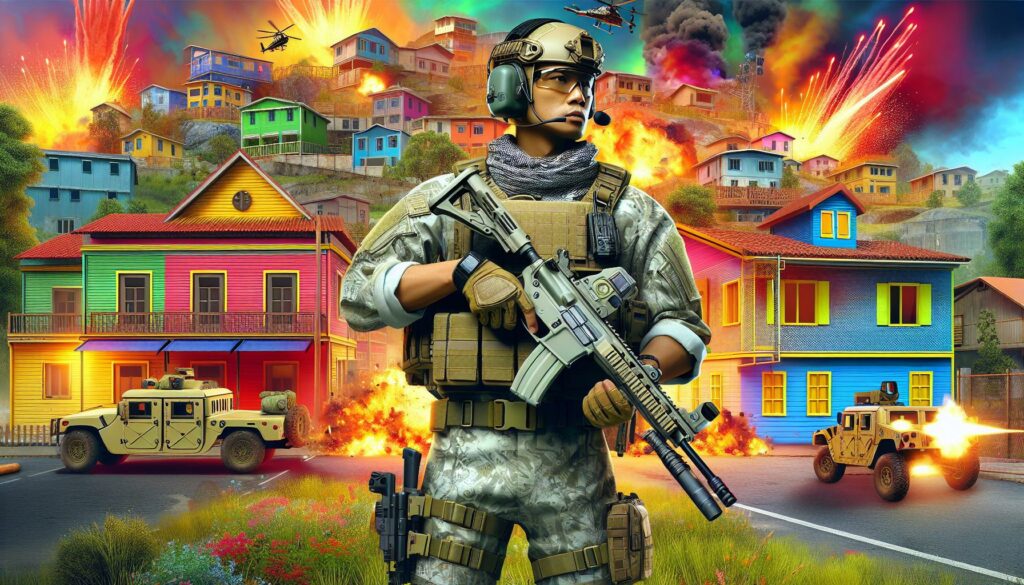As a longtime fan of the Call of Duty franchise, I’ve always been captivated by the diverse and intricate maps that bring each game to life. From sprawling urban landscapes to tight-knit close-quarter combat zones, each map offers unique challenges and strategies that keep the gameplay fresh and exhilarating. With so many titles released over the years, it can be tough to keep track of all the maps that have shaped our gaming experiences.
Key Takeaways
- Diverse Environments: Call of Duty maps range from urban landscapes to tight-knit areas, promoting various play styles and strategies for players.
- Iconic Maps: Classic maps like “”Nuketown”” and “”Terminal”” are fan favorites, known for their unique design and engaging gameplay that encourages fast-paced action.
- Expansive Layouts: Larger maps such as “”Verdansk”” require strategic positioning and adaptability, influencing the way players approach combat scenarios.
- Interactive Elements: Maps feature interactive components (like destructible environments and movable objects) that enhance gameplay dynamics and enable creative tactics.
- Community Favorites: Player discussions and feedback help determine the most popular maps, showcasing titles like “”Firing Range”” and “”Crash”” for their balanced gameplay experiences.
- Game-Specific Variations: Each Call of Duty title includes distinct maps that cater to different combat styles, emphasizing the importance of mastering these layouts for competitive play.
Call of Duty Maps List
Call of Duty maps serve as fundamental components that shape gameplay experiences. Each map offers diverse environments, facilitating a range of combat styles and strategies. Players encounter everything from sprawling urban landscapes to tightly knit areas, influencing both movement and tactics.
Maps like “”Nuketown”” provide a compact combat area that encourages fast-paced action. Conversely, maps such as “”Verdansk”” feature extensive terrains, promoting strategic positioning and long-range engagements. Each map introduces unique challenges, encouraging adaptability and teamwork.
The franchise consistently expands its map roster, with each new title bringing fresh locations and themes. Notable examples include “”Summit”” from Black Ops, which combines verticality with tight corridors, and “”Terminal”” from Modern Warfare 2, known for its recognizable airport setting that enhances immersion.
With numerous maps available across titles, players confront varying objectives and layouts. Competitive matches often require players to master multiple maps, understanding their intricacies. Each map contributes to the overall depth of gameplay, ensuring that each session feels distinct and engaging.
Popular Maps in Call of Duty History
Call of Duty features numerous maps that have defined gameplay experiences. Here’s a look at some of the most popular maps, categorized by classic and modern designs.
Classic Maps
- Nuketown
Nuketown offers a small, chaotic battleground. Its tight corridors and multiple structures promote fast-paced action, making it a fan favorite since its debut in Call of Duty: Black Ops. - Crash
Crash presents a post-apocalyptic urban setting. Players navigate through a ruined city environment, featuring rooftops and open spaces, fostering diverse combat strategies. - Terminal
Terminal unfolds in an airport terminal. The blend of interior and exterior spaces cultivates different combat styles, encouraging players to utilize long-range and close-quarters tactics effectively. - Firing Range
Firing Range delivers a compact environment tailored for intense engagements. It focuses on quick skirmishes and strategic positioning, appealing to competitive players.
- Verdansk
Verdansk introduces an expansive battle royale environment. Its varied terrains, from urban centers to rural areas, allow for diverse gameplay strategies and adaptability during matches. - Al Mazrah
Al Mazrah features intricate layouts with a mix of urban and natural landscapes. This recent addition requires players to adjust tactics based on environmental changes and enemy movements. - Blackout
Blackout revolutionizes the battle royale experience within the Call of Duty framework. The map emphasizes a unique blend of iconic locations from past titles, providing nostalgia while maintaining modern gameplay elements. - Rebirth Island
Rebirth Island provides a compact battleground suited for fast-paced action. This smaller environment promotes team-oriented gameplay, encouraging players to collaborate for victory.
These maps illustrate how Call of Duty continually evolves, offering players a variety of experiences and challenges across different game modes. Understanding the layout and strategies of these maps is crucial for achieving success in competitive play.
Map Design and Features
Call of Duty maps are intricately designed to enhance the gaming experience through their unique layouts and interactive elements. Each map introduces different features that cater to various play styles, requiring players to adapt their strategies.
Layout Considerations
Layout decisions significantly impact gameplay. Maps like “”Nuketown”” feature tight spaces encouraging close-quarter combat, while “”Verdansk”” offers expansive environments that demand strategic positioning. Players encounter verticality in maps like “”Highrise,”” utilizing elevated areas for sniping or flanking maneuvers. Navigation routes are often created through choke points and open lanes, influencing movement and engagement strategies. Familiarity with each layout contributes to effective map control and tactical advantages during gameplay.
Interactive Elements
Interactive elements on the maps add depth to gameplay dynamics. Items like ladders, doors, and vehicles create opportunities for quick movement or ambush tactics. Destructible environments in maps such as “”Battle Royale”” locations offer tactical advantages, allowing players to alter cover and sightlines. Additionally, killstreaks or map-specific events can trigger unique gameplay experiences, influencing player strategies during matches. Understanding these interactive components enhances engagement and encourages creative tactics, making each playthrough feel fresh and exciting.
Call of Duty Maps by Game Title
Call of Duty features a wide array of maps categorized by each game title. Understanding these maps enhances gameplay and strategic planning for players.
Call of Duty: Modern Warfare
Modern Warfare includes iconic maps such as “”Shoot House,”” “”Hackney Yard,”” and “”Gun Runner.”” Each map presents unique design elements.
- Shoot House: This map emphasizes fast-paced action within a tight space, ideal for close-quarters combat.
- Hackney Yard: Hackney Yard provides opportunities for verticality, allowing for diverse engagement strategies and flanking.
- Gun Runner: Gun Runner combines narrow corridors and open spaces, forcing players to adapt their tactics for both close and long-range skirmishes.
Familiarizing myself with the unique layouts and features of these maps directly influences success in competitive matches.
Call of Duty: Black Ops
Black Ops maps enhance gameplay with diverse environments and strategic elements. Popular maps in this series include “”Nuketown,”” “”Firing Range,”” and “”Havana.””
- Nuketown: This classic map promotes rapid action and intense firefights, fostering chaotic gameplay that requires quick reflexes.
- Firing Range: Firing Range provides a balanced mix of close quarters and long sightlines, challenging players to employ diverse combat strategies.
- Havana: Havana features a more urban layout, encouraging tactics such as flanking and ambushes due to its intricate pathways and cover options.
Mastering these maps allows players to maximize their effectiveness and gameplay experiences in Black Ops titles.
Community Favorites and Rankings
Community feedback plays a crucial role in identifying favorite maps in the Call of Duty series. Players frequently discuss their top choices in forums and social media, helping shape rankings through collective opinions.
- Nuketown: Known for its intense close-quarter battles, Nuketown ranks highly among fans. Its compact design encourages fast-paced gameplay, making it a staple in various Call of Duty titles.
- Terminal: Terminal’s varied levels and multiple vantage points provide engaging combat scenarios. Players appreciate the balance between indoor and outdoor environments, enhancing tactical gameplay.
- Rust: The small, vertical layout of Rust fosters quick engagements and aerial combat. Its frenetic pace appeals to players seeking adrenaline-pumping action.
- Firing Range: Firing Range delivers a balanced mix of open and enclosed spaces. Players enjoy the opportunities for strategic positioning, making it a frequent favorite in competitive matchups.
- Crash: Crash’s urban landscape and wide sightlines create diverse engagement opportunities. Its popularity stems from the map’s blend of close and ranged combat, catering to various play styles.
Community-driven rankings may vary, but these maps consistently gain recognition for their design and gameplay quality. Regular updates and new game iterations create fresh conversations around map preferences, as players share their experiences and strategies, keeping the community engaged.
Exploring the diverse maps in the Call of Duty franchise has deepened my appreciation for the game’s intricate design and strategic depth. Each map brings its own unique flavor and challenges that keep players engaged and adapting. Whether it’s the fast-paced action of “”Nuketown”” or the expansive strategies required in “”Verdansk,”” mastering these environments is key to enhancing gameplay.
The constant evolution of maps reflects the franchise’s commitment to providing fresh experiences. As I continue to dive into new titles and revisit classics, I look forward to discovering even more strategies and tactics that these maps offer. The journey through Call of Duty’s map landscape is as thrilling as the battles themselves, and I can’t wait to see what’s next.



